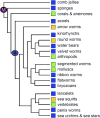Causes and evolutionary consequences of primordial germ-cell specification mode in metazoans
- PMID: 28584112
- PMCID: PMC5468662
- DOI: 10.1073/pnas.1610600114
Causes and evolutionary consequences of primordial germ-cell specification mode in metazoans
Abstract
In animals, primordial germ cells (PGCs) give rise to the germ lines, the cell lineages that produce sperm and eggs. PGCs form in embryogenesis, typically by one of two modes: a likely ancestral mode wherein germ cells are induced during embryogenesis by cell-cell signaling (induction) or a derived mechanism whereby germ cells are specified by using germ plasm-that is, maternally specified germ-line determinants (inheritance). The causes of the shift to germ plasm for PGC specification in some animal clades remain largely unknown, but its repeated convergent evolution raises the question of whether it may result from or confer an innate selective advantage. It has been hypothesized that the acquisition of germ plasm confers enhanced evolvability, resulting from the release of selective constraint on somatic gene networks in embryogenesis, thus leading to acceleration of an organism's protein-sequence evolution, particularly for genes expressed at early developmental stages, and resulting in high speciation rates in germ plasm-containing lineages (denoted herein as the "PGC-specification hypothesis"). Although that hypothesis, if supported, could have major implications for animal evolution, our recent large-scale coding-sequence analyses from vertebrates and invertebrates provided important examples of genera that do not support the hypothesis of liberated constraint under germ plasm. Here, we consider reasons why germ plasm might be neither a direct target of selection nor causally linked to accelerated animal evolution. We explore alternate scenarios that could explain the repeated evolution of germ plasm and propose potential consequences of the inheritance and induction modes to animal evolutionary biology.
Keywords: epigenesis; germ line; preformation; primordial germ cell; spandrel.
Conflict of interest statement
The authors declare no conflict of interest.
Figures

Similar articles
-
Contrasting patterns of molecular evolution in metazoan germ line genes.BMC Evol Biol. 2019 Feb 11;19(1):53. doi: 10.1186/s12862-019-1363-x. BMC Evol Biol. 2019. PMID: 30744572 Free PMC article.
-
Evolution of the germ line-soma relationship in vertebrate embryos.Reproduction. 2011 Mar;141(3):291-300. doi: 10.1530/REP-10-0474. Epub 2011 Jan 12. Reproduction. 2011. PMID: 21228047 Review.
-
Refuting the hypothesis that the acquisition of germ plasm accelerates animal evolution.Nat Commun. 2016 Aug 31;7:12637. doi: 10.1038/ncomms12637. Nat Commun. 2016. PMID: 27577604 Free PMC article.
-
Acquisition of germ plasm accelerates vertebrate evolution.Science. 2014 Apr 11;344(6180):200-3. doi: 10.1126/science.1249325. Science. 2014. PMID: 24723612
-
Evolution of predetermined germ cells in vertebrate embryos: implications for macroevolution.Evol Dev. 2003 Jul-Aug;5(4):414-31. doi: 10.1046/j.1525-142x.2003.03048.x. Evol Dev. 2003. PMID: 12823457 Review.
Cited by
-
Testis Development and Differentiation in Amphibians.Genes (Basel). 2021 Apr 16;12(4):578. doi: 10.3390/genes12040578. Genes (Basel). 2021. PMID: 33923451 Free PMC article. Review.
-
Single-cell analysis of Schistosoma mansoni identifies a conserved genetic program controlling germline stem cell fate.Nat Commun. 2021 Jan 20;12(1):485. doi: 10.1038/s41467-020-20794-w. Nat Commun. 2021. PMID: 33473133 Free PMC article.
-
Inheritance of somatic mutations by animal offspring.Sci Adv. 2022 Sep 2;8(35):eabn0707. doi: 10.1126/sciadv.abn0707. Epub 2022 Aug 31. Sci Adv. 2022. PMID: 36044584 Free PMC article.
-
Contrasting patterns of molecular evolution in metazoan germ line genes.BMC Evol Biol. 2019 Feb 11;19(1):53. doi: 10.1186/s12862-019-1363-x. BMC Evol Biol. 2019. PMID: 30744572 Free PMC article.
-
Uncoupling cell division and cytokinesis during germline development in metazoans.Front Cell Dev Biol. 2022 Nov 3;10:1001689. doi: 10.3389/fcell.2022.1001689. eCollection 2022. Front Cell Dev Biol. 2022. PMID: 36407108 Free PMC article. Review.
References
-
- Extavour CG, Akam M. Mechanisms of germ cell specification across the metazoans: Epigenesis and preformation. Development. 2003;130(24):5869–5884. - PubMed
-
- Ewen-Campen B, Schwager EE, Extavour CG. The molecular machinery of germ line specification. Mol Reprod Dev. 2010;77(1):3–18. - PubMed
-
- Johnson AD, Richardson E, Bachvarova RF, Crother BI. Evolution of the germ line-soma relationship in vertebrate embryos. Reproduction. 2011;141(3):291–300. - PubMed
-
- Tam PP, Zhou SX. The allocation of epiblast cells to ectodermal and germ-line lineages is influenced by the position of the cells in the gastrulating mouse embryo. Dev Biol. 1996;178(1):124–132. - PubMed
Publication types
MeSH terms
Grants and funding
LinkOut - more resources
Full Text Sources
Other Literature Sources

